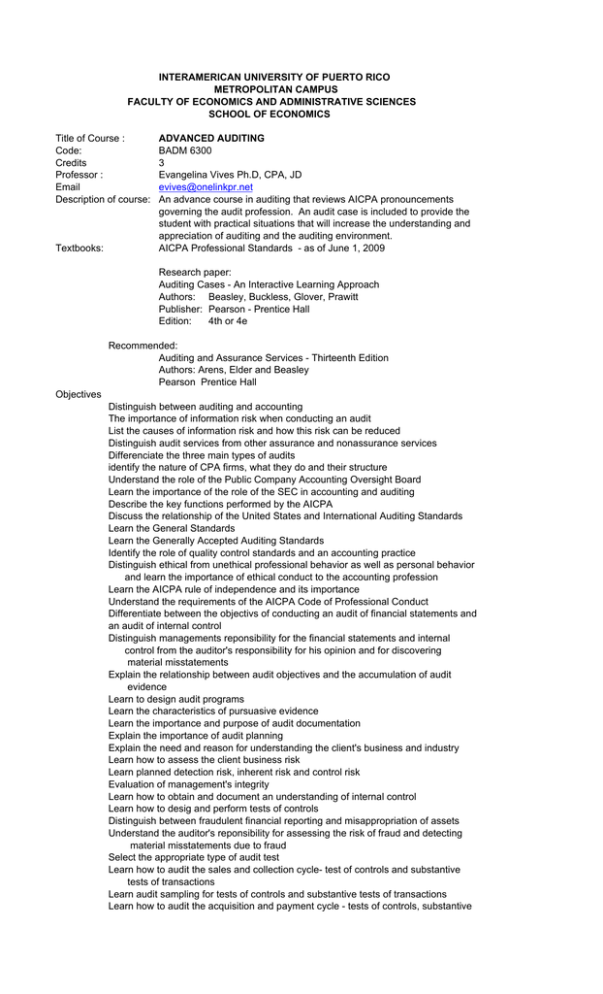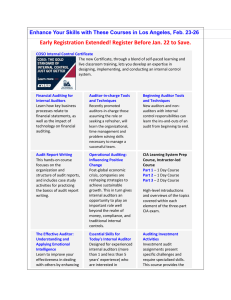
INTERAMERICAN UNIVERSITY OF PUERTO RICO
METROPOLITAN CAMPUS
FACULTY OF ECONOMICS AND ADMINISTRATIVE SCIENCES
SCHOOL OF ECONOMICS
Title of Course :
Code:
Credits
Professor :
Email
Description of course:
Textbooks:
ADVANCED AUDITING
BADM 6300
3
Evangelina Vives Ph.D, CPA, JD
evives@onelinkpr.net
An advance course in auditing that reviews AICPA pronouncements
governing the audit profession. An audit case is included to provide the
student with practical situations that will increase the understanding and
appreciation of auditing and the auditing environment.
AICPA Professional Standards - as of June 1, 2009
Research paper:
Auditing Cases - An Interactive Learning Approach
Authors: Beasley, Buckless, Glover, Prawitt
Publisher: Pearson - Prentice Hall
Edition:
4th or 4e
Recommended:
Auditing and Assurance Services - Thirteenth Edition
Authors: Arens, Elder and Beasley
Pearson Prentice Hall
Objectives
Distinguish between auditing and accounting
The importance of information risk when conducting an audit
List the causes of information risk and how this risk can be reduced
Distinguish audit services from other assurance and nonassurance services
Differenciate the three main types of audits
identify the nature of CPA firms, what they do and their structure
Understand the role of the Public Company Accounting Oversight Board
Learn the importance of the role of the SEC in accounting and auditing
Describe the key functions performed by the AICPA
Discuss the relationship of the United States and International Auditing Standards
Learn the General Standards
Learn the Generally Accepted Auditing Standards
Identify the role of quality control standards and an accounting practice
Distinguish ethical from unethical professional behavior as well as personal behavior
and learn the importance of ethical conduct to the accounting profession
Learn the AICPA rule of independence and its importance
Understand the requirements of the AICPA Code of Professional Conduct
Differentiate between the objectivs of conducting an audit of financial statements and
an audit of internal control
Distinguish managements reponsibility for the financial statements and internal
control from the auditor's responsibility for his opinion and for discovering
material misstatements
Explain the relationship between audit objectives and the accumulation of audit
evidence
Learn to design audit programs
Learn the characteristics of pursuasive evidence
Learn the importance and purpose of audit documentation
Explain the importance of audit planning
Explain the need and reason for understanding the client's business and industry
Learn how to assess the client business risk
Learn planned detection risk, inherent risk and control risk
Evaluation of management's integrity
Learn how to obtain and document an understanding of internal control
Learn how to desig and perform tests of controls
Distinguish between fraudulent financial reporting and misappropriation of assets
Understand the auditor's reponsibility for assessing the risk of fraud and detecting
material misstatements due to fraud
Select the appropriate type of audit test
Learn how to audit the sales and collection cycle- test of controls and substantive
tests of transactions
Learn audit sampling for tests of controls and substantive tests of transactions
Learn how to audit the acquisition and payment cycle - tests of controls, substantive
Page 2
tests of transactions, and accounts payable
Learn how to audit the payroll and personell cycle
Learn how to audit the capital acquisition and repayment cycle
Learn how to audit cash balances
Learn all the procedures to complete the audit including the accountant's report
Content:
SECTION
PAGE TITLE
ET Appendix A 1765
Part 1 - The Public Accounting Profession and its Relationship to Financial Accounting
AU Appx A
967
Historical Background
BL - 911
1945
AICPA Mission Statement
BL - 921
1947
A Description of the Professional Practice of Certified Public Accountants
ET Appx A
1765
Council Resolution Designaiting Bodies to Promulgate Technical Standards
AU - 410
565
Adherence to Generally Accepted Accounting Principles
FASB No. 162
The Hierchy of Generally Accepted Accounting Principles
Part 1
23
Applicability of AICPA Professional Standards and Public Company
Accounting Oversight Board Standards
AU - 544
689, 749 Lack of Conformity with GAAP
ET - 203
1705
Accounting Principles (Rule 203)
Part 2 - The Public Accounting Profession: Auditing and Other Functions
ET - 92
1651
Definitions
AU 120
45
Definng Professional Requirements in Statements on Audidting Standards
Compliance with Standards
ET - 202
1703
General Standards
ET - 201
1701
ET - 50
1593
Code of Professional Conduct
Generally Accepted Auditing Standards
AU - 150
47
AU - 201
55
Nature of the General Standards (GAAS)
AU - 210
57
Training and Proficiency of the Independent Auditor
AU - 220
59
Independence
ET-100.01
1627
Conceptual Framework for AICPA Independence Standards
ET - 101
1635
Independence
AU - 230
61
Due Professional Care in the Performance of Work
AU - 110
41
Responsibilities and Functions of the Independent Auditor
AU - 504
603
Association with Financial Statements
VS
1961
Statement on Standards for Valuation Services
CS
2013
Consulting Services
QC
2021
Quality Control
PR
2049
Standards for Performing and Reporting on Peer Reviews
TS
2201
Tax Services
PFP
2241
Personal Financial Planning
CPE
2275
Continuing Professional Education
AT
1097
Statements on Standards for Attestation Engagements
AT 201
1177
Agreed-Upon Procedures Engagements
AT 301
1195
Financial Forecasts and Projections
AT 401
1231
Reporting on Pro Forma Financial Information
AT 501
1247
Examination of an Entity's Internal Control
AT 601
1295
Compliance Attestation
AT 701
1317
Management's Discussion and Analysis
AR
1399
Statements on Standard for Accounting and Review Services
SECTION
PAGE
TITLE
Part 3 - Fraud and illegal acts
AU 316
167
Consideration of Fraud in a Financial Statement Audit
AU 317
219
Illegal Acts by Clients
Part 4 - The standard audit report, modificaions and other rypes of reports and letters
AU 311
81
Planning and Supervision
AU 315
159
Communications Between Predecessor and Successor Auditors
AU 508
613
Reports on Audited Financial Statements
AU 543
675
Part of Audit Performed by Other Independent Auditors
AU 341
505
The Auditor's Consideration of an Entity's Ability to Continue as a Going
Concern
AU 337
443
Inquiry of a Client's Lawyer Concerning Litigation,Claims and Assessments
AU 431
595
Adequacy of Disclosure in Financial Statements
AU 420
AU 530
AU 560
AU 561
AU 390
AU 532
AU 623
AU 380
AU 625
AU 534
AU 550
AU 551
581
530
723
729
559
661
745
541
625
667
693
699
Page 3
Consistency of Application of GAAP
Dating an Independent Auditor's Report
Subsequent Events
Subsequent Discovery of Facts Existing at the Date of the Report
Consideration of Omitted Procedures After the Report Date
Restricting the Use of an Auditor's Report
Special Reports
The Auditor'a Communication With Those Charged With Governance
Reports on the Application of Accounting Principles
Reporting on Financial Statements Prepared For Use in Other Countries
Other Information In Documents Containing Audited Financial Statements
Reporting on Information Accompanying the Basic Financial Statements
In Auditor Submitted Documents
Course evaluation:
Tests
There will be a single all term inclusive final test that will be counted for
50% of the grade.
Term Paper The term paper will be the other 50% of the final grade.
Attendance The attendance to class is required. For every three absences the grade
will be reduced once.
Additional sections that you must use and refer to in your answer to your research paper when
applicable:
AU 312
95
Audit Risk and Materiality in Conducting an Audit
AU 314
115
Understanding the Entity and Its Environment and Assessing the Risks
of Material Misstatement
AU 318
229
Performing Audit Procedures in Response to Assessed Risks and
Evaluating the Audit Evidence Obtained
AU 322
253
The Auditor'a Consideration of the Internal Audit Function in an Audit of
Financial Statements
AU 324
263
Service Organizations
AU 325
291
Communicating Internal Control Related Matters Identified in an Audit
AU 326
317
Audit Evidence
AU 328
333
Auditing Fair Value Measurements and Disclosures
AU 329
347
Analytical Procedures
AU 330
355
The Confirmation Process
AU 331
367
Inventories
AU 332
373
Auditing Derivative Instruments, Hedging Activities, and Investments in
Securities
AU 333
399
Management Representations
AU 334
419
Related Parties
AU 336
429
Using the Work of a Specialist
AU 339
487
Audit Documentation
AU 342
515
Auditing Accounting Estimates
AU 350
525
Audit Sampling
AU 552
707
Reporting on Condensed Financial Statements and Selected Financial Data
AU 558
713
Required Supplementary Information
AU 634
795
Letters for Underwriters and Certain Other Requesting Parties
Case Assigned:
Authors:
Publisher:
TERM PAPER
Auditing Cases - An Interactive Learning Approach
Beasley, Buckless, Glover, Prawitt
Pearson - Prentice Hall Fourth Edition or Fourth Edition E
The Term Paper is considered to be an independent study to be submitted the last day of class.
Students may elect to work alone or with one other student only. The term paper must be
accompanied by all the members of the group indicating the contribution to the term paper of each
member of the group. When addressing solutions to problerms, the student should indicate the
source used preferably the Statements on Auditing Standards when applicable. Please do not
use a textbook as reference because they are not authoritative guidelines.
Page 4
CASES ASSIGNED
Client Acceptance
1.1 Ocean Manufacturing, Inc.
Understanding the Client's Business and Assessing Risk
2.2 Dell Computer Corporation
2.4 Asher Farms Inc.
Professional and Ethical Issues
3.1 A Day in the Life of Brent Dorsey
3.3 The Anonymous Caller
3.4 WorldCom
3.5 Hollinger International
Accounting Fraud and Auditor Legal Liability
4.2 Comptronic Corporation
4.3 Cendant Corporation
4.4 Waste ManXerox Corporation
Internal Control over Financial Reporting
5.1 Simply Steam. Co.
5.2 Easy Clean, Co.
5.3 Red Bluff Inn & Café
5.5 Collins Harp Enterprises
5.6 Sarbox Scooter, Inc.
The Impact of information Technology
6.1 Harley-Davidson, Inc.
Planning Materiality
7.1 Anne Taylor, Inc.
Analytical Procedures
8.1 Laramie Wire Manufacturing
8.2 Northwest Bank
8.3 Burlingham Bees
Auditing Cash and Revenues
9.1 Wally's Billboard & Sign Supply
9.2 Henrico Retail, Inc.
9.3 Longeta Corporation
9.4 Bud's Big Blue Manufacturing
Planning and Performing Auddit Procedures in the Revenue and Expenditure Cycles
10.1 Southeast Shoe Distributor, Inc.
10.2 Southeast Shoe Distributor, Inc.
10.3 Southeast Shoe Distributor, Inc.
10.4 Southeast Shoe Distributor, Inc.
10.5 Southeast Shoe Distributor, Inc.
Developing and Evaluating Audit Documentation
11.1 The Runners Shop
Completing the Audit, Reporting to Managmenrt, and External Reporting
12.2 Auto Parts, Inc.
12.4 Surfer Dude Duds, Inc.
12.5 Murchison Technologies, Inc.
Special Notes
A. Special Accomodations
Students who require special accommodations must request these services at the
beginning of the course as soon as they notice that they need help. Students can
access the service with Professor Jose Rodriguez, Coordinator of Students with Special
Needs at the Guidance and counseling office on the first floor at Metro's Student Center.
B. Plagiarism, dishonesty, fraud and any other type of manipulation or inappropriate
behavior related with academic performance are unacceptable in our institution.
Disciplinary actions will be taken on students found guilty of such practice as established
in Chapter V, Article 1, Section B.2 of the Student's Rules and Regulations Handbook.
Inter-American University has very strict regulations regarding plagiarism (using the ideas
or words of others without giving proper credit), so it is important that you specifically
read Chapter V, Article 1, Section B.2C of the Student's Rules and Regulations Handbook.
This section clearly explains what plagiarism is. In addition, it explains the types of
sanctions students are exposed to when they commit it.
C. Use of Electronid Devices
Cellular (mobile) telephones and any other electronic device that could interrupt the
teaching-learning process or disrupt a milieu favorable for academic excellence will be
deactivated. Critical situations will be dealt with an appropriate manner. The use of
electronic devices that permit the accessing, storing or sending of data during tests or
examinations is prohibited.








